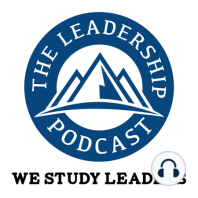33 min listen

TLP314: How Posture & Nonverbal Behaviors Communicate More Than You Think
TLP314: How Posture & Nonverbal Behaviors Communicate More Than You Think
ratings:
Length:
53 minutes
Released:
Jul 6, 2022
Format:
Podcast episode
Description
Richard Newman is the Founder and CEO of BodyTalk. In 21 years, Richard’s team has trained over 100,000 business leaders globally to improve their communication and impact. Richard learned recently that he is high-functioning on the autism spectrum; and he feels it blessed him by guiding his life in a deep exploration of communication. He shares how he teaches the hero’s journey to improve storytelling in meetings. Richard tells of the importance of nonverbal behaviors and of a research study he conducted with University College London on the effectiveness of postures and nonverbal behavior in projecting leadership qualities. Richard has great advice for leaders on lifting others to become the best versions of themselves. https://bit.ly/TLP-314 Key Takeaways [2:24] If Richard had been taller or a better player, he may have become a professional basketball player. He was sort of born in the wrong country. When he comes to the U.S., he loves going to watch basketball. There’s not much of a basketball industry in the UK. [4:11] At age 17, Richard taught 11-year-olds at his school how to play basketball, to keep up with other schools. He thought of going into teaching. He went to a monastery in India on a gap program and taught the monks English, using only a chalkboard, body language, and tone of voice. At the end of the first lesson they could confidently speak a few English words and they loved it. He taught for six months. [7:30] Richard learned from teaching English that to communicate well, he had to have congruency between his body language, his tone of voice, and his words. To teach the word “excited” he had to sound and look excited. Congruency is one of the key elements of great communication. That principle became foundational to BodyTalk, the company he founded. [8:56] Richard learned Nepali in India, the easiest dialect of the three languages spoken in the city where the monastery was located. He became more fluent in Nepali than in the French or German he had learned in school. [10:44] The biggest communication error is to treat people as human “doings” rather than human beings. Presentations seek to engage the logical mind. Studies show that the emotional brain engages first, and then sends a memo to the logical brain telling it what to notice. Before a meeting (or email), ask yourself, “How do I need people to feel by the end of this meeting (or email)?” [13:32] Everybody talks about storytelling; they know they need it, but few people understand what it is. Robert McKee says when you listen to a piece of music, you don’t automatically think you would be a great composer. When thinking of storytelling, why do you assume you would be a great storyteller? There is a framework you can learn to be able to tell stories well. [14:11] Storytelling allows us to give people information in the way the brain wants to receive it, engaging the survival mind, the emotional mind, and then, finally, the logical mind. Joseph Campbell’s The Hero With A Thousand Faces introduced this structure in 1949 after having studied how people of different civilizations that never had contact with each other have told stories through the centuries. [15:01] Christopher Vogler in the 1980s reduced Campbell’s 17-steps of the hero’s journey into 12 steps. Richard Newman has simplified those steps into five sections that his company teaches people to use for composing an email or making a presentation. [15:30] If you want to cascade information, frame an important message, or pitch your business, learn the power of storytelling. Richard tells of a client who went from a win rate of one in four to a 100% win rate in the space of a year, getting over a billion dollars of new business. Frame the information to engage the survival and emotional brain, the logical brain, and then get people to take action at the end. [16:50] Jim Carey said that constantly talking isn’t necessarily communicating. The way to turn any information into a more engaging sto
Released:
Jul 6, 2022
Format:
Podcast episode
Titles in the series (100)
TLP006: Get to Know the Hosts of The Leadership Podcast: The inspiration behind this endeavor and what listeners should expect to gain from it. by The Leadership Podcast